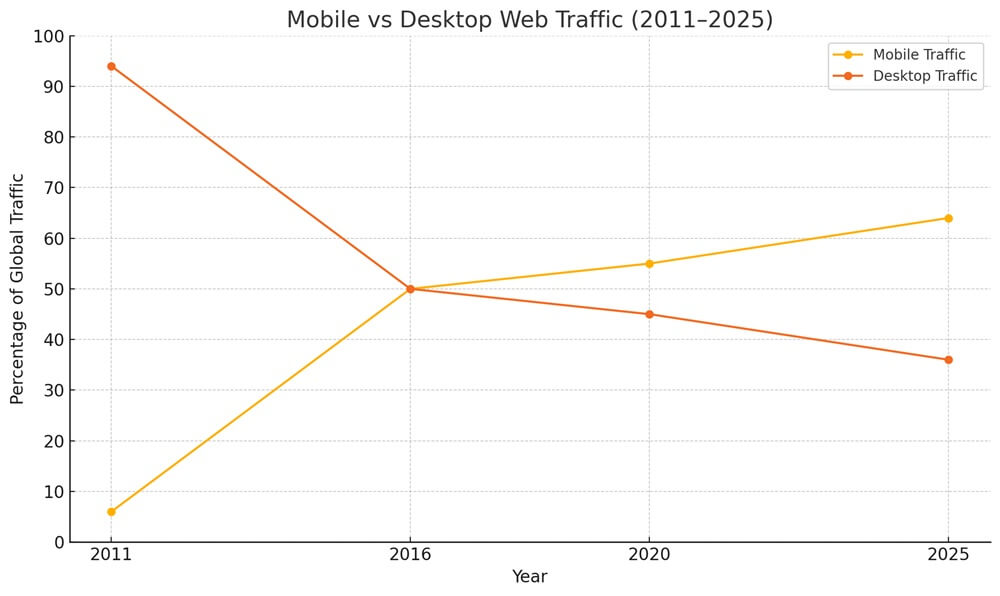Back
How web technology has transformed in the last two years
Web Technology in 2025: How Sites Must Evolve to Compete
Web technology has evolved rapidly in recent years. If your website hasn’t kept up, you could be losing visibility, traffic and conversions. In 2025, users expect fast-loading, mobile-first websites that build trust and make it easy to take action.
Mobile-first is no longer optional
In 2025, 64% of global web traffic comes from mobile devices. In the UK, that rises to 67%. Nearly 98% of UK adults are online, and 95% of them own smartphones. If your website still isn’t responsive or intuitive on mobile, you’re falling behind. Users expect fast load times, tap-friendly navigation and accessible content across all screen sizes.
Google rewards speed and usability
Google’s Core Web Vitals measure how quickly and smoothly your pages load. But only 47% of websites currently pass Core Web Vitals in 2025. Pages that often see a conversion rate increase of up to 20%. Simple technical fixes like image compression and lazy loading can make a big difference.
Fresh, relevant content matters more than ever
Outdated blogs or static homepages send the wrong signals. Regularly publishing industry news, product updates, and FAQs helps establish authority and keeps users engaged. Content should answer search intent, support internal linking and be easy to skim. Content marketing isn’t just about volume; it’s about value.
SEO and web technology go hand-in-hand
Your website architecture, meta tags, image attributes and structured data all influence how Google interprets your pages. If you’ve not reviewed your site’s SEO framework in the last 12–18 months, now’s the time. Modern SEO relies heavily on technical health as well as keyword relevance.
Is your CMS helping or hurting you?
Many legacy content management systems (CMS) are bloated, slow or insecure. Switching to a more agile platform or optimising your current one can significantly improve site performance. Features like schema integration, page-level SEO control and mobile previews should come as standard in 2025.
Security and privacy now impact reputation
SSL certification, cookie consent and GDPR-compliant forms aren’t just regulatory issues. Users are far less likely to engage with a site that looks untrustworthy. A visible security badge and clear privacy messaging are basic requirements in today’s digital landscape.
Are you tracking user journeys?
Understanding how visitors move through your site helps refine navigation and increase conversion. Heatmaps, goal tracking and user recordings offer deep insights. If you’re still relying solely on Google Analytics, consider additional tools like Hotjar or Microsoft Clarity.
Don’t overlook accessibility
Modern web technology prioritises inclusive design. Your site should be accessible to users with visual, motor or cognitive impairments. This includes alt text for images, keyboard navigation, colour contrast and clear heading hierarchy. Accessibility is also an SEO ranking factor in 2025.
Link your site to a wider digital strategy
A well-built site only performs when connected to your full marketing strategy. Integrating it with paid campaigns, social media, and email nurture flows ensures visitors continue engaging after their first visit.
How Purplex helps businesses modernise
We don’t just build websites. We develop fully optimised, user-focused digital platforms tailored to your audience, goals and commercial strategy. Whether you need a rebuild or want to improve what you already have, our team delivers.
Talk to us about upgrading your web technology
If your current site feels slow, looks dated or doesn’t convert, we’ll fix it. Our web design team build mobile-optimised, SEO-ready websites that support your wider digital goals. Contact us today to request a free web audit or consultation.
Recent Web Technology Statistics (2025)
| Metric | Value | Source |
|---|---|---|
| Global mobile traffic | 64.35% | Exploding Topics, July 2025 |
| UK mobile traffic | 67.05% | SimilarWeb, June 2025 |
| UK internet penetration | 97.8% | DataReportal, 2025 |
| UK smartphone ownership | 95% | Finder UK, 2025 |
| Chrome global browser share | 66% | Wikipedia, Feb 2025 |
| Sites passing Core Web Vitals | 47% | Magnet, May 2025 |
| Typical conversion uplift | Up to 20% | Magnet, 2025 |
Graph: Mobile vs Desktop Web Traffic (2011–2025)
This graph shows the shift in global web traffic from desktop to mobile between 2011 and 2025. It highlights the increasing dominance of mobile usage and supports the argument for adopting mobile-first web technology.

Graph showing mobile and desktop web traffic over time. The image visually represents the growth of mobile usage in global web traffic and the decline of desktop browsing. It supports the blog’s message on evolving web technology and why businesses must prioritise mobile-friendly websites in 2025.
This entry was posted in Web Development





